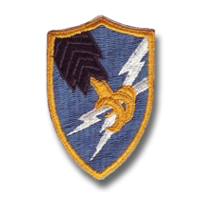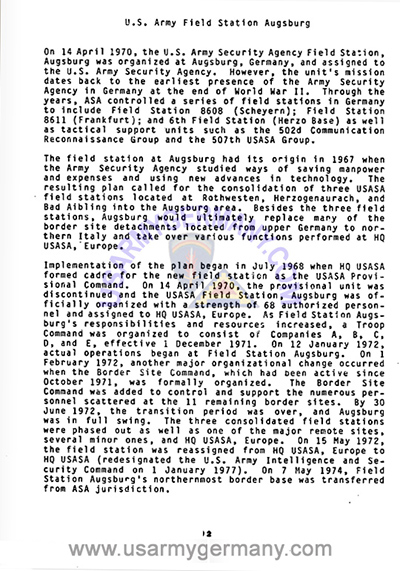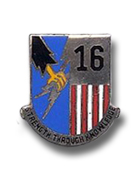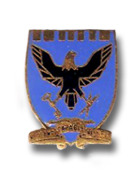| If you do NOT see the Table of Contents frame to the left of this page, then Click here to open 'USArmyGermany' frameset |
||||||||
|
Army
Security Agency, Europe |
||||||||
|
|
||||||||
|
||||||||
|
|
||||||||
| Field Stations | ||||||||
| 18th Field Station, Bad Aibling | ||||||||
 Headquarters Building, 18th USASA FS Bad Aibling, 1968 (Terry Huffaker) |
||||||||
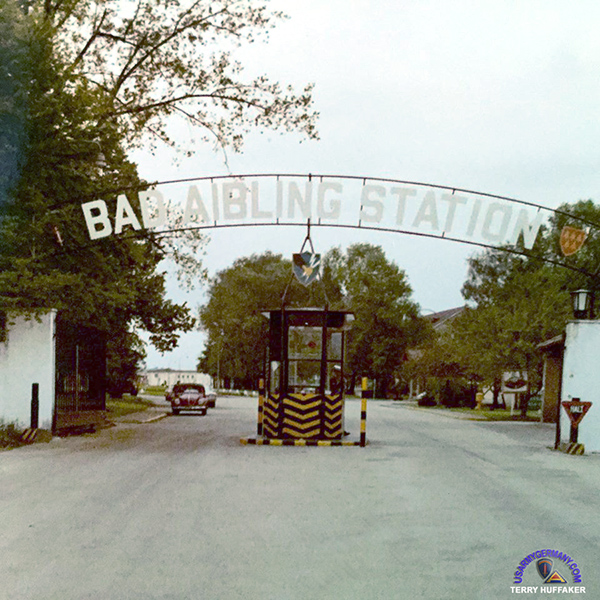 Main Gate of Bad Aibling Station, 1968 (Terry Huffaker) |
||||||||
| 1970 | ||||||||
| (Source: Email from Thomas Nunn) | ||||||||
| I served in Germany from Jan 1970 till Mar 1972 -- as a member of the Army Security Agency. I was stationed in Berlin for about six months and then transferred to Bad Aibling Germany for the remainder of my tour. There I was assigned to "F" Branch. Our listening equipment was located inside an old WW2 German hangar -- Bad Aibling was a German fighter training base during the war. Our particular section was located in the old parts room.
On our door was a timelock -- which opened every 8 hours to allow for shift change. We monitored "Scheds", or scheduled transmissions, in 8 different languages. These scheds consisted of traffic sent in numbers, divided into groups of five. Each message could be of varying sizes. The first line of the message was always the number of the specific person the message was intended for. There could be as many as 100 recipients in one sched.
While I was stationed in Berlin, we would take a bus every day to the top of the Teufelsberg Mountain. This "mountain" was built after the war with the rubble left after the Allied bombings of Berlin.
We sat at listening positions, or "Pozes". Each of these pozes consisted of 32 individual reel-to-reel tape recorders, one 32 channel microwave decoder, a small metal desk -- on which sat a 32 switch toggle-switch box with 32 lights just above the switches, which was connected to the tape recorders. There was also a typewriter which was fed with 8-ply NCR paper sheets.
Each time that a tape recorder came on, the corresponding light on the box would light up. I forgot to mention that the operator of the poz wore headphones. We would then toggle the switch below the light and listen to what was being said. If it sounded important, we would continue to monitor the conversation; if not, we would turn the recorder off, mark and date the paper, and wait for the next one.
We also had sections listening to the other Iron Curtain countries and one listening to a "mysterious" signal coming from "outer space". We even had a section listening to the Soviet space missions.
ADDITIONAL INFORMATION: I got to Berlin in January, 1970. The intelligence community was still smarting from the Russian invasion of Czechoslovakia. Why? Because the Soviet army had moved an entire tank division from about 10 mile south of Berlin to the Czech border without breaking radio silence. In other words, the NATO people lost track of them -- an entire division. You know that our armed forces couldn't do that in 1970.
The first inkling the West got that there was a problem was the Czech border guards asking their government for permission to fire on the Soviet tank columns, permission which was quickly denied.
Well, late in 1970 the same type situation developed with Romania. Now, ya'll never heard about this one. See, the Russians liked to conduct massive field maneuvers twice a year. We always loved those times because we got super busy identifying units and putting together an order of battle. When they Ruskies went out, they required the other Warsaw Pact countries to send units as well. Most of the time, the "puppet" countries went along.
This time, however, the Romanians told the Russians to shove it. They were in the midst of harvest, and flatly refused to play. Which pissed the Russians off a bunch. So, the Ruskies sent a division to slap some sense into the Romanian government, and once again we didn't know anything about it. Until we heard the Romanian border guards requesting permission to open fire -- which the Romanian government quickly granted. However, the Russians blinked and cooler heads intervened. Crisis averted -- sort of. See, NATO told the Romanians that if they got into a shooting arguement with Russian we would step in and help them. The actual end result was the overthrow of the Romanian government and their replacement with Russian approved tyrants. We were truly only hours from war in Europe -- our butts were puckered, let me tell you.
|
||||||||
| Field Station Augsburg | ||||||||
(Source: Excerpt from the Special Historical Series pub, "INSCOM And Its Heritage," published in 1985) |
||||||||
| 1982 | ||||||||
| (Source: AUGSBURG SCENE, February 4, 1982) | ||||||||
| Field Station celebrates tenth anniversary by Colonel Michael Schneider) The 12th of January 1982 marked the official 10th Anniversary of US Army Field Station Augsburg. As you will see by the short history that follows, several different dates could possibly have been chosen as the official birthday, but 12 January has been formally recognized and serves as good a day to commemorate as any. Ten years is not a very long life when measured in terms of humans or other military organizations and one could observe that in that sense, the Field Station is almost an adolescent. But the twenty-four-hour-a-day, seven-day-a-week pace we have maintained since our birth ten years ago makes that decade the equivalent of 30 to 40 years activity at a more traditional pace. So in that sense, Field Station Augsburg is, at its 10th birthday, a mature, productive activity at the peak of its useful life. I thought that in recognition of this 10th Anniversary, a review of the Field Station's Birth and organizational history would be interesting. The concept of Field Station Augsburg (FSA) began in January 1967, with a study organized by the CG, US Army Security Agency (ASA). This study considered consolidation of several existing ASA stations. The goal of this study effort was to save on manpower and expenses and to exploit new technology on a large scale. After the study's acceptance at national level, the Augsburg location was chosen, in part for technical reasons and in part because of existing troop support facilities. The first cadre for the station was formed by HQ, USASA Europe as the USASA Provisional Command in July 1968, and was tasked to supervise preparations. The unit name USASA Field Station Augsburg (still provisional) became official on 14 April 1970, when a DA General Order authorized the new unit. At that time FSA had 68 personnel. It would absorb or replace three smaller Field Stations (Rothwestern, Herzogenaurach, Bad Aibling); five company sized border sites (Gross Gusborn, Wobeck, Mt. Meissner, Mt. Schneeberg, Eckstein); seven small detachments, from near Denmark to northern Italy; and HQ, USASA Europe at Frankfurt. One small Air Force field station was also relocated (from Darmstadt) to share the new facilities, along with a small Navy detachment. Formal activation of FSA took place on 12 January 1972. FSA's original structure consisted of an Operations Center to run the mission, the station staff concerned with support functions, and a Troop Command with six billeting companies and a transient detachment. In October 1971, however, Border Site Command was added to control and support the 500-plus personnel scattered at eleven remaining remote sites. The staff included a company sized Signal Office, 200-plus maintenance and supply personnel within S-4, and the separate Data Processing Division. By June of 1972, FSA was in full swing and the three supplanted stations, one large border site, three smaller sites, and HQ, USASA Europe had been closed. In September 1972, the new 1000-man Gablingen Dining Facility opened. Two more of Border Site Command's smaller detachments were closed in December 1972. Company E at Gablingen and Headquarters and Headquarters Company at Flak Kaserne moved in early 1973, bringing Troop Command all together on Sheridan Kaserne, while HQ, FSA and HQ, Border Command remained at Flak. The number of women serving at FSA was increasing dramatically at this time, and in January 1973, Company D was redesignated as a WAC company. A two-year project to transfer FSA's most northern border base (Gross Gusborn) to the British was completed on 7 May 1974. Two months previously another minor site had been closed. This left Border Site Command with three major sites and only three detachments (one at Schleswig and two at Bad Aibling). The long, friendly relationship with Communications Activity South of the Bundeswehr (CASB) began with the collocation of the first small German element in the summer of 1974. That summer also marked the beginning of construction of the Headquarters Annex at Gablingen Kaserne. In September 1974, after a year of planning, FSA began the single greatest reorganization in its existence, which resulted in the basic battalion structure that we have today. The reorganization was formalized by DA on 28 April 1975. In addition to the elements we currently know, Support Battalion included a Communications Company, and Border Command became Forward Operations Battalion, with three border companies and two detachments. On 1 October 1975, HQ, FSA vacated Flak Kaserne for its new building at Gablingen. In early 1976, the La Faire Vite project, in preparation since the founding of the Field Station, was activated. Its two small border sites replaced the three company sites of Forward Operations Battalion. This battalion was deactivated in April of that year and its two remaining detachments were transferred to 3rd Operations Battalion. 1st Operations Battalion was assigned control of the La Faire Vite operations. As a consequence of the formation of Intelligence and Security Command (INSCOM) in October 1976, US Army Security Agency Field Station Augsburg was redesignated US Army Field Station Augsburg in May of 1977. On 1 October 1977, Communications Company assets were transferred to the Army Communications Command (ACC) with no change in mission, and became USACC Activity-INSCOM, Augsburg. The company was assigned to the 5th Signal Command but was OPCON to FSA. Also, on 1 October, the local Special Security Office of new Special Security Group was formed with personnel from the FSA S-2 section, with a primary mission to support the Field Station. These were the last major changes to FSA up to the present day. We did close one detachment in 1980 and established another, and we recently added the small Document Destructor building at Gablingen, but our basic structure has been stable now for four years. There is one historic note from this year, however. It seems that on 12 January, one year ago, Thorbrau Brewery and Field Station Augsburg inaugurated the now famous "Field Station Beer" label. |
||||||||
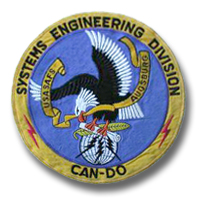 Systems Engineering Div, USASAFS Augsburg Systems Engineering Div, USASAFS Augsburg |
||||||||
| Field Station, Berlin | ||||||||
(Source: Excerpt from the Special Historical Series pub, "INSCOM And Its Heritage," published in 1985) |
||||||||
| 17th Field Station, Rothwesten | ||||||||
| 1963 | ||||||||
| (Source: Email from Ron Ruiz) | ||||||||
| I was an ASAer from 1963 to 1968. After many schools in the States I was stationed at the 17th USASA Field Station in Kassel (Rothwesten) for my entire Army career. I actually spent very little time at the FS as I was part of a "flyaway team" that manned or filled in for other ASAers at remote duty stations. I was at Luebeck until the station closed and also spent a lot of time at the Gartow site or Fort Gartow as we called it. I had permanent living quarters with a farm family in Pevestorf (near Det L Site). I even married a girl from Gartow and stayed in Germany when I was separated from the Army. My daughter was born in Dannenberg (near Gartow). I belong to a group of ex ASA Luebeck guys and that website can be found at www.lubeckers.com. There are approximately 300 members in that group. They hold an annual reunion somewhere in the US and an occasional reunion in Luebeck, Germany (next one is in 2009). The website contains a lot of information and photos. Other than the Luebeck and Gartow sites I was also stationed at Mt. Meisner and Helmstedt for short periods of time. I have numerous photos of the 17th FS, the Gartow site, the Luebeck site, and the Mt. Meisner site. I need to scan the photos and if you are interested I can forward them to you for your use. |
||||||||
| (Source: THE TALON, 17th FS newsletter) | ||||||||
|
||||||||
|
||||||||

